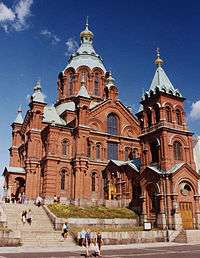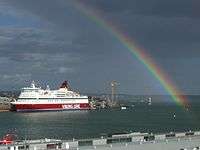Katajanokka
| Katajanokka Skatudden | |
|---|---|
| Helsinki Subdivision | |
 Position of Katajanokka within Helsinki | |
| Country |
|
| Region | Uusimaa |
| Sub-region | Greater Helsinki |
| Municipality | Helsinki |
| Subdivision number | 08 |
| District | Southern |
| Subdivision regions | none |
| Area | 0.57 km2 (0.22 sq mi) |
| Population (2005) | 4,167 |
| • Density | 7,244/km2 (18,760/sq mi) |
| Postal codes | 00160 |
| Neighbouring subdivisions |
Kruununhaka Kaartinkaupunki |
Katajanokka (Swedish: Skatudden) is a neighbourhood of Helsinki, Finland, with around 4000 inhabitants in 2005. The district is located adjacent to the immediate downtown area, though in the first major town plan for Helsinki from the mid-18th century, the area fell outside the fortifications planned to encircle the city. Originally, it was a headland of the Helsinki peninsula but is now technically an island, as a small canal was dug across the base of the headland in the 19th century. Katajanokka is one of the most distinguished neighbourhoods in Helsinki. Katajanokka's residents include former Finnish President (from 1982 to 1994) Mauno Koivisto and composer Einojuhani Rautavaara.

Overview
The south side of Katajanokka is dominated by a passenger harbour which is frequented by large cruiseferries traveling between Helsinki, Stockholm, Mariehamn, Tallinn and Rostock. The rest of the district comprises co-operative apartment buildings and several small parks. The western part of the residential area, known as the "Old Side" of Katajanokka, is an upscale neighborhood and a well-preserved example of early 20th century Art Nouveau architecture, though up until the mid-19th century – while the centre of Helsinki was being filled with stone buildings – the area was essentially still a wooden shanty town. The eastern part was for a long time a closed military area containing a naval base and shipyard, later a commercial shipyard. It was redeveloped in the 1970s and 1980s into a mainly residential zone, often referred to as the "New Side" of Katajanokka. The new residential area is considered an exceptional example of modern town planning. A major part of the project was the conversion and extension of the old Russian naval barracks to house the Finnish foreign ministry.
The northern shore of Katajanokka still serves as a base for the Finnish coast guard, Helsinki maritime police as well as the Finnish icebreaker fleet.


Landmarks of Katajanokka include the Russian Orthodox Cathedral, also known as Uspenski Cathedral (architect Alexey Gornostaev, 1868), the Merikasarmi complex of the Foreign Ministry (architect Carl Ludvig Engel, 1825) and the Finnish headquarters of Stora Enso (architect Alvar Aalto, 1962; the most controversial of Aalto's works).

Another famous building in Katajanokka is the former district prison of Southern Finland. The old prison dates back to 1837, and functioned as a prison until 2002. The prison underwent an extensive interior renovation to convert the cells of the prison into hotel rooms, with sets of two or three cells combined to make up the current hotel rooms. The Best Western Premier Hotel Katajanokka opened in May 2007 with 106 guest rooms. Renovations cost a reported 15 million euro.[1] As a historic building, strict limits were imposed on the redevelopment due to the strict regime of protection for historically significant buildings that is in effect in Finland. Thus, as a hotel, the exterior of the building has been preserved, as has the central corridor of the old prison and even the old prison wall. A restaurant at the lowest level of the hotel has attempted to keep much of the character of the old prison alive, and is called the "Jailbird Restaurant". However, an actual former prisoner told a Finnish newspaper that the supposed "prison cutlery" is very different from what the prison actually used: for example, prisoners never drank out of tin cups.

During the development of Katajanokka in the 1970s and 1980s, many old red brick industrial buildings were spared by converting them for public uses, such as a primary school and an indoors sports arena. Recently, there was controversy over the demolition of the former cadet school of the Russian navy, built in the early 20th century. Vacated by the Finnish military in the 1980s, the building survived, with various uses, mainly as a cultural centre. In the late 1990s, the city of Helsinki announced that it was going to demolish the building to build a new apartment building in its place. This caused huge protests, and the demolition was put off for almost a decade, mainly because of opposition from local inhabitants, and the Green League party.
The navy school building was finally demolished in autumn 2006. However, additional problems resulted: Contrary to what the city of Helsinki and the architecture bureau responsible for the new building had thought, there was no solid rock bottom underneath the old building, but only scattered rocks here and there. Because the original building had stood there since Czarist Russia, no original construction plans were available, and therefore the new plans had to be redone from scratch.

The local community organisation of Katajanokka is called Katajanokkaseura. The organization publishes an annual regional magazine, Katajanokan kaiku (Finnish for "The Echo of Katajanokka").
There is an annual running event called the Katajanokan ympärijuoksu, open for everyone who lives in Katajanokka or has relatives living there.
Architecture

Katajanokka is principally known for its fine examples of Jugendstil architecture. Other prominent styles apparent on the island are modernism, manifested in Alvar Aalto's Enso-Gutzeit Building, and the red-brick industrial former harbour buildings and prison (now a Best Western hotel).
Politics
Results of the Finnish parliamentary election, 2011 in Katajanokka:
- National Coalition Party 35.0%
- Green League 20.1%
- Social Democratic Party 13.0%
- Swedish People's Party 8.8%
- Left Alliance 8.8%
- True Finns 8.0%
- Centre Party 3.8%
- Christian Democrats 1.2%
Economy

Kesko has its head office in the district.[2]
Literature

- Griffiths, Gareth (1997). The Polemical Aalto. The Enso-Gutzeit Building (1959-62), Datutop 19, Tampere. ISBN 951-722-789-2 (an account of the saga of Aalto's controversial building on Katajanokka.)
- Jaatinen, Carina & Lindh, Tommi & Lunkka, Hannu (1998). Helsingin kantakaupungin rakennuskulttuuri. Katajanokan kaupunginosan inventointi. Helsingin kaupunginmuseo. ISBN 951-718-174-4. (An examination of the architectural history of Katajanokka.)
- Kervanto Nevanlinna, Anja (2002). Kadonneen kaupungin jäljillä. Teollisuusyhteiskunnan muutoksia Helsingin historiallisessa ytimessä. ("Tracing the lost city. Industrial transformations in the historical heart of Helsinki. With summary and captions in English.") Suomalaisen Kirjallisuuden Seura. ISBN 951-746-307-3. (Takes a critical look at the 20th Century transformation of the Eteläsatama seafront in Helsinki, with an emphasis on Katajanokka.)
- Moorhouse, Jonathan & Carapetian, Michael & Ahtola-Moorhouse, Leena (1987). Helsinki Jugendstil 1895—1915. Otava Verlag. ISBN 951-1-08382-1. (Describes the architecture of Katajanokka, p. 198—228. Also available in Finnish as ISBN 951-1-09018-6.)
- Narinkka (1989). Helsinki City Museum. (A detailed exploration of the history of Katajanokka before the 20th Century. Written by Viljo Erkamo and Kerttuli Wessman. Includes an English summary, titled "Katajanokka's humble past. Old drawings and paintings: a documentary record of city ethnography".) ISSN 0355-9106.
- Ollila, Kaija & Toppari, Kirsti (1975): Puhvelista Punatulkkuun. Helsingin vanhoja kortteleita. Sanoma Osakeyhtiö. ISBN 951-9134-69-7. (Information and historical anecdotes on the city blocks and buildings of Helsinki. Covers the entire "Old Side" of Katajanokka, among other districts.)
Articles in architectural journals
- Arkkitehti 1931. Frequently cited debate from the early 1930s regarding the state and the future of Katajanokka.
- Helander, Vilhelm & Pakkala, Pekka & Sundman, Mikael: Katajanokan kärjen asemakaavaluonnos. ("The draft plan for the 'tip of Katajanokka'") Arkkitehti 2/1975, p. 32 pp. Early description of the winning plan for the "New Side" by the architects involved.
- Pakkala, Pekka: Katajanokan vanhan asuntoalueen asemakaava ("The plan for the old residential area of Katajanokka"). Arkkitehti 4/1981, p. 42 pp. Detailed article on the preservation of the "Old Side".
References
External links
| Wikimedia Commons has media related to Katajanokka. |
- Katajanokka home site
- Buildings of the "Old Side" of Katajanokka — Pictures of all the buildings of the "Old Side", with information on the architects and dates of erection of each building
- Etymology and pronunciation of Skatudden (in Swedish) — An article on the Swedish name of Katajanokka, published by the Research Institute for the Languages of Finland
Coordinates: 60°10′01″N 024°58′06″E / 60.16694°N 24.96833°E
